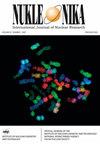Simulated nuclear contamination scenario, solid cancer risk assessment, and support to decision
IF 0.3
4区 物理与天体物理
Q4 CHEMISTRY, INORGANIC & NUCLEAR
引用次数: 6
Abstract
Abstract The detonation of an (hypothetical) improvised nuclear device (IND) can generate atmospheric release of radioactive material in the form of particles and dust that ultimately contaminate the soil. In this study, the detonation of an IND in an urban area was simulated, and its effects on humans were determined. The risk of solid cancer development due to radiation was calculated by taking into account prompt radiation and whole-body exposure of individuals near the detonation site up to 10 km. The excess relative risk (ERR) of developing solid cancer was evaluated by using the mathematical relationships from the Radiation Effects Research Foundation (RERF) studies and those from the HotSpot code. The methodology consists of using output data obtained from simulations performed with the HotSpot health physics code plugging in such numbers into a specific given equation used by RERF to evaluate the resulting impact. Such a preliminary procedure is expected to facilitate the decision-making process significantly.模拟核污染情景,实体癌风险评估,并支持决策
(假设的)简易核装置(IND)的爆炸可以产生以颗粒和灰尘形式向大气释放的放射性物质,最终污染土壤。在这项研究中,模拟了一枚原子弹在城市地区的爆炸,并确定了它对人类的影响。辐射引起实体癌的风险是通过考虑爆炸地点附近10公里范围内个人的即时辐射和全身暴露来计算的。通过使用辐射效应研究基金会(RERF)研究和热点代码的数学关系来评估发生实体癌的超额相对危险度(ERR)。该方法包括使用HotSpot健康物理代码进行模拟获得的输出数据,将这些数字插入到RERF使用的特定给定方程中,以评估由此产生的影响。预期这一初步程序将大大促进决策进程。
本文章由计算机程序翻译,如有差异,请以英文原文为准。
求助全文
约1分钟内获得全文
求助全文
来源期刊

Nukleonika
物理-无机化学与核化学
CiteScore
2.00
自引率
0.00%
发文量
5
审稿时长
4-8 weeks
期刊介绍:
"Nukleonika" is an international peer-reviewed, scientific journal publishing original top quality papers on fundamental, experimental, applied and theoretical aspects of nuclear sciences.
The fields of research include:
radiochemistry, radiation measurements, application of radionuclides in various branches of science and technology, chemistry of f-block elements, radiation chemistry, radiation physics, activation analysis, nuclear medicine, radiobiology, radiation safety, nuclear industrial electronics, environmental protection, radioactive wastes, nuclear technologies in material and process engineering, radioisotope diagnostic methods of engineering objects, nuclear physics, nuclear reactors and nuclear power, reactor physics, nuclear safety, fuel cycle, reactor calculations, nuclear chemical engineering, nuclear fusion, plasma physics etc.
 求助内容:
求助内容: 应助结果提醒方式:
应助结果提醒方式:


